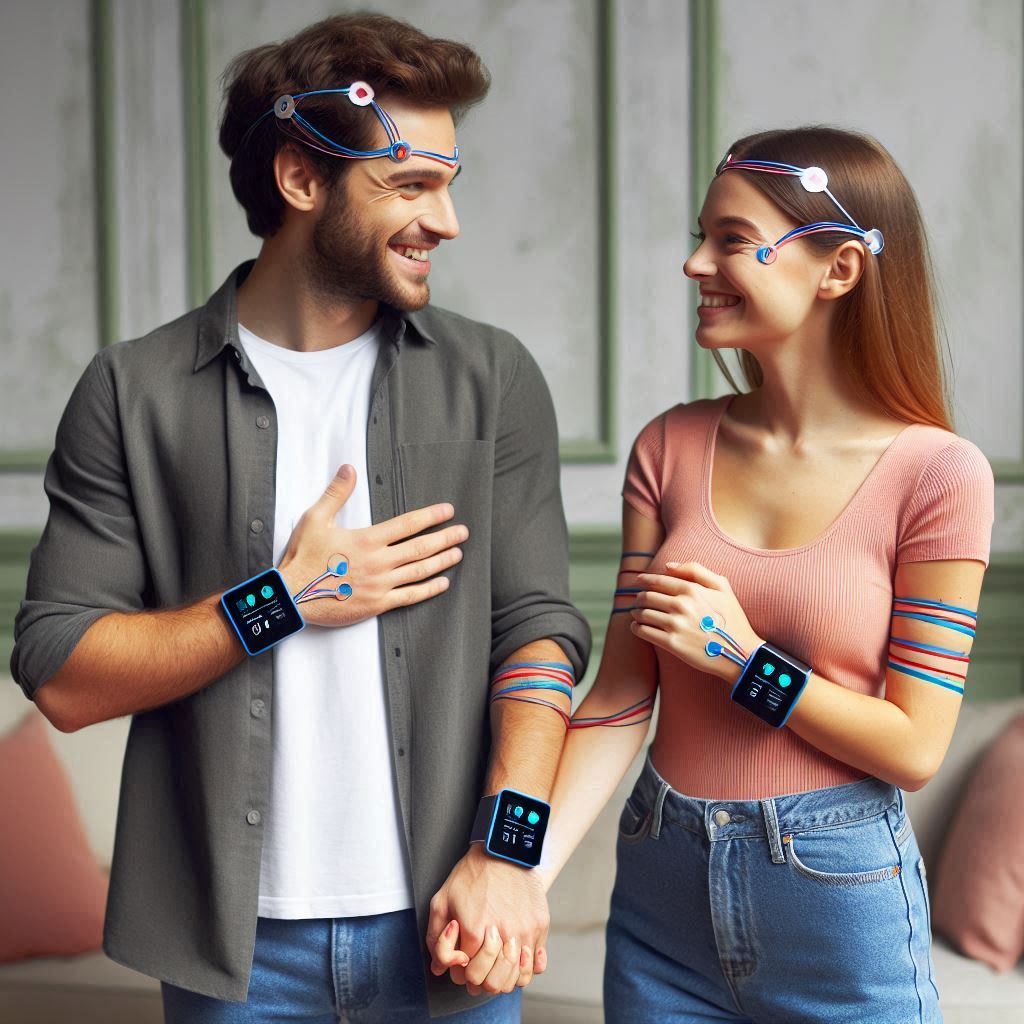Introduction
Technology’s influence on personal relationships
Technology increasingly shapes personal relationships in our modern world.
From the way we communicate to how we connect emotionally, tech influences love profoundly.
Biometric sensors stand at the forefront of this evolution.
These devices monitor physiological responses, revealing insights into our emotional states.
Overview of biometric sensors and their application in tracking emotions
Biometric sensors, such as heart rate monitors and skin conductance sensors, capture data that reflects emotional reactions.
They measure responses like heart rate variability and sweat gland activity, linking them to feelings of joy, love, or anxiety.
With this technology, individuals can gain a deeper understanding of their emotional lives and their partners’ feelings.
The rise of relationship apps and smart wearables emphasizes the utility of biometric sensors.
Many of these applications use emotional data to help couples improve communication and strengthen bonds.
By analyzing heart rate patterns, for instance, couples can identify moments of emotional peak or stress, fostering empathy and understanding.
This technology acts as a unique bridge to deeper emotional connections.
The purpose of the blog: to explore how tech measures and affects emotional bonds
This blog will explore how technology measures and influences emotional bonds.
We will examine the ways biometric sensors track feelings and contribute to relationship dynamics.
Through understanding this technology, we can learn how to enhance our love lives in meaningful ways.
As we delve deeper into the world of biometric sensors, we will discover how they facilitate emotional awareness.
Innovative Tech Solutions, Tailored for You
Our leading tech firm crafts custom software, web & mobile apps, designed with your unique needs in mind. Elevate your business with cutting-edge solutions no one else can offer.
Start NowEquipped with this knowledge, individuals can navigate their relationships with greater insight and intention.
Ultimately, technology can serve as a powerful ally in the quest for deeper emotional connections.
Join us in exploring the intersection of technology and love, as we uncover amazing insights that may transform your relationship.
Together, we can explore how tech enhances emotional intimacy, helping us forge stronger bonds in a digital age.
Understanding Biometric Sensors
Biometric sensors represent a remarkable intersection of biology and technology.
They measure physical and behavioral characteristics to identify individuals.
These sensors continually evolve, adapting to advances in technology and our understanding of human emotional responses.
Definition and Functionality
A biometric sensor captures unique biological data.
It determines identity based on physical traits.
By measuring specific metrics, it can provide insights into emotional states and reactions.
The technology typically involves direct interaction with the user.
These sensors function through various techniques.
They often utilize electrical signals, optical scanning, or sound wave separation.
Each technology serves to quantify biological traits into actionable data.
Types of Biometric Sensors Relevant to Emotional Tracking
Several types of biometric sensors play a role in detecting emotions.
Three major categories include:
- Heart Rate Monitors: These devices track heartbeats, providing data on emotional arousal.
- Skin Conductance Sensors: These sensors measure sweat gland activity, indicating stress or excitement.
- Facial Recognition Software: This technology analyses facial expressions to infer emotional states.
Heart Rate Monitors
Heart rate monitors offer direct insight into emotional reactions.
They can determine the user’s physiological response to various stimuli.
For example, an increased heart rate may indicate excitement, stress, or fear.
Wearable devices like smartwatches now include heart rate monitoring capabilities.
Users can experience real-time feedback on their emotional states.
The correlation between heart rate and emotional responses can provide valuable insights into relationship dynamics.
Skin Conductance Sensors
Skin conductance sensors provide another layer of emotional tracking.
These sensors detect changes in perspiration, which correlate with emotional arousal.
Seamless API Connectivity for Next-Level Integration
Unlock limitless possibilities by connecting your systems with a custom API built to perform flawlessly. Stand apart with our solutions that others simply can’t offer.
Get StartedEmotional states like anxiety, excitement, or fear can trigger sweating.
By monitoring these changes, researchers can assess how emotional intensity varies in different situations.
This sensor can provide a window into the subtleties of emotional relationships.
Facial Recognition Software
Facial recognition software studies facial expressions for emotional analysis.
It examines micro-expressions and major facial movements.
This technology helps identify emotions like happiness, sadness, anger, or surprise.
Using artificial intelligence, these systems recognize patterns in facial data.
Advanced algorithms interpret the emotional significance of different expressions.
This gives couples insights into their interactions, fostering better communication.
Data Collection and Relationship Dynamics
The data collected from biometric sensors can significantly inform relationship dynamics.
Couples can gain various insights into emotional interactions through this technology.
By quantifying emotions, these devices can highlight patterns in behavior and responses.
Through heart rate data, couples may understand stress triggers during conflicts.
It can reveal when one partner feels overwhelmed.
This knowledge can help partners respond more empathetically during disagreements.
Skin conductance data may illuminate moments of heightened emotion, such as jealousy or excitement.
Tracking these moments allows partners to identify emotional hot spots in their relationship.
It opens up discussions about personal feelings and reactions.
Facial recognition software offers a unique glimpse into unspoken emotions.
Partners can see how their expressions change during conversations.
This awareness may promote more open dialogue and foster deeper connections.
Practical Applications
Practically, biometric sensors can enhance relationships in multiple ways.
Couples can use these technologies to monitor emotional states in real-time.
This monitoring can foster more supportive environments.
Transform Business with Custom CRM & ERP Solutions
Elevate your operations with a CRM or ERP tailored for you. Let’s build the perfect solution that others can't replicate—crafted to match your business's needs like no other.
Get StartedFor instance, a couple might wear heart rate monitors during a stressful event, such as a public speaking engagement.
By understanding each other’s physiological cues, they can provide necessary support.
This knowledge helps them cope better together.
Moreover, journaling emotional data from skin conductance sensors can reveal long-term trends.
Couples can reflect on challenges that arise in specific contexts, such as family gatherings or social events.
Utilizing facial recognition technologies could help partners communicate better.
Empathizing with each other becomes easier when they understand what their partner feels.
This awareness ultimately leads to a more profound emotional bond.
In summary, biometric sensors offer an innovative way to explore emotional connections.
These technologies empower individuals to understand their emotional landscapes better.
By tracking heart rates, skin conductance, and facial expressions, partners can enhance their relationships considerably.
The insights provided by biometric data not only foster personal growth, but they also encourage healthier interactions.
As we embrace these advances, we can revolutionize emotional connections.
Blending technology with human experience opens new pathways to love and understanding.
Read: Smart Home Devices Enhancing Romantic Connections
The Science of Emotions and Love
Understanding the emotional bonding process is pivotal in grasping how individuals connect with one another.
Emotional bonds form the foundation of love and attachment.
They consist of intricate psychological mechanisms that foster deep relationships.
Emotional Bonding and Its Psychological Underpinnings
Emotional bonding encompasses various psychological aspects.
Here are key elements that contribute to emotional bonding:
- Attachment Styles: Different attachment styles shape how individuals connect. Secure, anxious, and avoidant styles influence relationship dynamics.
- Emotional Availability: Partners must be emotionally available. This willingness to share feelings strengthens relationships.
- Mutual Understanding: Emotional bonds thrive on shared experiences. Understanding each other’s emotions fosters closeness.
- Empathy: Empathy plays a vital role. It allows individuals to feel another’s emotions, reinforcing connection.
- Trust: Trust is essential in building emotional bonds. It enables individuals to feel safe and secure in relationships.
These elements intertwine to create a robust emotional bond.
Psychological theories explain how these connections nurture love and intimacy.
The Correlation of Physical Responses with Emotional States
Physical responses provide valuable insights into emotional states.
Here are common physical reactions associated with emotional experiences:
Tailored Tech Solutions to Drive Your Business Forward
Maximize your business potential with custom tech strategies. We deliver bespoke solutions that others can’t match, designed to solve your specific challenges with precision and impact.
Contact Us- Heart Rate Changes: Love and excitement increase heart rates. This physiological response indicates heightened emotional states.
- Sweating: Sweat may be a response to anxiety or attraction. Emotional arousal can cause noticeable perspiration.
- Pupil Dilation: Attraction leads to pupil dilation. This response reveals interest and emotional engagement.
- Breathing Patterns: Emotions impact breathing. Rapid breathing may accompany fear or excitement, while slow breathing can indicate calmness.
- Skin Conductance: Emotional responses affect skin conductance. Increased arousal leads to greater conductivity in the skin.
Researchers have extensively studied these physical responses.
They establish a clear link between bodily reactions and emotional states.
Understanding this connection reveals how technology can track emotional bonds.
Key Theories of Emotion
Several theories have influenced our understanding of emotions.
These theories provide a framework for analyzing relationships and emotional bonds.
Here are some notable theories:
- James-Lange Theory: This theory suggests that physiological arousal precedes emotional experience. Your heart races, then you feel fear or excitement.
- Cannon-Bard Theory: According to this theory, physiological responses occur simultaneously with emotional experiences. Your heart races and you feel the emotion at the same time.
- Schachter-Singer Theory: This theory posits that emotion is the result of physiological arousal and cognitive interpretation. You interpret your racing heart and label the emotion.
- Attachment Theory: This psychological model emphasizes the importance of early attachments in adult relationships. Bonding with caregivers influences how individuals form romantic relationships.
- Social Exchange Theory: This theory posits that relationships are based on perceived costs and benefits. Emotional bonding strengthens when individuals feel they gain more than they invest.
Each of these theories supports the notion that emotions and physiological responses are interconnected.
They underscore the potential of biometric data to enhance our understanding of love and emotional bonds.
The Role of Biometric Sensors in Tracking Emotional States
Biometric sensors play a crucial role in monitoring emotional responses.
They provide real-time data that helps us understand emotions better.
Here are some of the most commonly used biometric sensors:
- Heart Rate Monitors: These devices measure heart rate variability, a key indicator of emotional arousal.
- Galvanic Skin Response Sensors: These sensors track changes in skin conductance, reflecting emotional reactions.
- Temperature Sensors: Changes in body temperature can indicate emotional shifts. Increased temperature often correlates with emotional arousal.
- Wearable Fitness Trackers: These devices collect data on various physiological parameters, providing insights into emotional states during intimate moments.
- Facial Recognition Software: Advanced technologies analyze facial expressions to detect emotional cues quickly.
These sensors enable researchers and individuals to collect crucial emotional data.
They help identify patterns between physical responses and emotional states, revealing the depth of emotional connections.
In fact, understanding the science of emotions and love provides a foundation for exploring biometric sensors in emotional tracking.
The intricate dynamics of emotional bonding reveal how technology can enhance our understanding of relationships.
By leveraging biometric data, we can uncover profound insights into emotional connections, enriching our experience of love and intimacy.
This intersection of technology and emotional bonds opens doors to new possibilities.
As we explore these connections, we foster deeper understanding and better communication in our relationships.
Read: The Role of AI in Conflict Resolution for Modern Couples
Applications of Biometric Sensors in Relationships
As technology continues to evolve, the integration of biometric sensors in our daily lives becomes more profound.
These sensors provide insights into our emotional states and connections with others.
In the context of relationships, they serve as tools for understanding and enhancing emotional bonds.
Below, we explore real-world applications, illustrative case studies, and the platforms using biometric data for relationship enhancement.
Real-world examples of biometric sensors in dating and relationship contexts
Today, many couples are embracing wearable technology.
These devices include smartwatches, fitness trackers, and even smart clothing.
Here are some prominent examples:
- Wearable Fitness Trackers: Devices like Fitbit and Apple Watch monitor heart rate, sleep patterns, and activity levels. Couples use this data to boost each other’s fitness and overall well-being.
- Smart Rings: Rings like Oura Track physiological signals, including heart rate variability. Couples can share data to understand emotional and physical states better.
- Emotional App Sensors: Devices such as Biofeedback Headbands measure stress levels by monitoring brain activity.
These devices help couples become aware of their emotional responses during conversations.
These tools enable individuals to share their biometric data, fostering vulnerability and deeper emotional exchanges.
Couples can now truly understand each other’s feelings and physiological responses, paving the way for stronger bonds.
Case studies illustrating how couples have used tech to enhance their emotional connection
Numerous couples have embraced biometric technology to deepen their emotional understanding.
Here are a couple of notable case studies:
- John and Sarah: This couple wore fitness trackers during a year-long relationship experiment. They shared daily statistics, which helped them analyze their sleep quality and stress levels.
They learned to discuss their feelings more openly, leading to improved communication. - Tom and Lisa: Utilizing smart rings, this couple monitored their heart rates during arguments. They discovered that high heart rates often indicated heightened emotions.
This realization allowed them to take breaks and discuss feelings more rationally, responsible decision-making rather than reacting impulsively.
These case studies emphasize how technology serves as a bridge for couples.
It cultivates trust and understanding, helping them navigate emotional landscapes together.
By objectively tracking physiological responses, partners can approach difficult conversations with data to support their emotions.
Discussion on apps or platforms that utilize biometric data for relationship enhancement
Numerous apps and platforms are emerging that leverage biometric data for relationship enhancement.
These tools not only analyze data but also foster meaningful conversations and emotional growth.
Some of these innovative solutions include:
- Breathe: This app combines biofeedback with mindfulness techniques. It helps couples practice deep breathing together, synchronizing their heart rates and fostering emotional connection.
- LoveSync: This platform allows couples to share biometric data anonymously. It sets thresholds for emotional responses and encourages discussions about stress levels and emotional states.
- Couple: This app creates a private space for partners to communicate. It integrates with wearable sensors to suggest activities based on emotional and physical data, like taking a walk when stress levels are high.
These applications encourage couples to use their biometric data constructively.
They provide tangible ways to support emotional intelligence and foster deeper connections.
As couples actively engage with this tech, they enhance their relationships and individual well-being.
Benefits of Utilizing Biometric Sensors
The advantages of incorporating biometric sensors in relationships are compelling.
Here are a few key benefits:
- Enhanced Communication: Biometric data offers objective insights. Couples can engage in discussions grounded in tangible facts, leading to more honest dialogues.
- Increased Emotional Awareness: Recognizing physiological signals builds self-awareness and awareness of one’s partner.
This understanding reduces misinterpretations of behavior and emotional states. - Support During Difficult Times: Biometric monitoring can provide real-time feedback during stressful moments. Couples can learn to respond more empathetically to each other’s needs.
- Strengthened Bonds: Shared technology usage fosters teamwork. Joint engagement in health and wellness activities builds camaraderie and strengthens emotional ties.
By leveraging these benefits, couples can create a more profound emotional understanding, leading to healthier, more fulfilling relationships.
The integration of biometric sensors revolutionizes how partners connect and support each other.
Challenges and Considerations
Despite numerous benefits, there are challenges to consider when utilizing biometric sensors.
Privacy concerns loom large, as sharing personal physiological data involves vulnerability.
Couples must establish trust in how they use this information.
Additionally, there can be a technology dependency.
Some couples may start relying only on data instead of personal intuition.
Balancing technology and emotional intelligence is crucial in maintaining healthy relationships.
Furthermore, individuals may feel overwhelmed by constant monitoring.
It is essential for couples to set boundaries around data sharing.
Create open discussions about readings and feelings to maintain emotional wellness.
Finally, the effectiveness of biometric sensors can vary among individuals.
Some may not respond positively to constant feedback, leading to stress rather than connection.
Couples should define what works for them, ensuring a positive experience.
Biometric sensors offer a fascinating perspective on emotional connections in relationships.
They provide valuable tools for monitoring, understanding, and enhancing bonds between partners.
While there are challenges, the potential for deeper understanding makes these technologies worth exploring.
As couples navigate the landscape of love and technology, the insights they gain can lead to healthier, more fulfilling relationships and shared experiences.
Read: 5G Networks Revolutionizing Long-Distance Relationships

Benefits and Advantages of Using Technology to Track Emotions
In today’s digital age, technology significantly impacts our emotional connections.
Biometric sensors help us better understand our feelings.
These devices have numerous advantages that can enhance relationships.
Let’s explore the key benefits that technology provides in emotional tracking.
Improved Communication Between Partners
Effective communication forms the backbone of any healthy relationship.
Technology enhances the way partners interact.
Biometric sensors, like heart rate monitors, provide real-time emotional data.
This data allows partners to identify and address emotional shifts.
Understanding each other’s emotional states helps reduce miscommunication.
For instance, if one partner feels anxious, the other can respond with empathy.
By being aware of these feelings, partners can engage in meaningful conversations.
Technological insights encourage openness, fostering a stronger connection.
This awareness creates a safe space for discussing emotions.
Moreover, apps that track emotional data generate reports.
These reports provide insights into recurring patterns and triggers.
Such information lets partners recognize and discuss sensitive topics.
Improved communication eliminates uncertainty and builds trust.
Increased Awareness of Emotional States Leading to Stronger Bonds
Biometric technology provides insights into emotional states that often go unnoticed.
Many individuals struggle to articulate their feelings.
Tools such as mood trackers help users become more self-aware.
Increased awareness supports emotional growth and maturity.
For example, a wearable device can display heart rate and stress levels.
When one partner notices increased stress, they can address underlying causes.
This immediate action fosters a deeper understanding between partners.
Emotional awareness cultivates an environment of support and understanding.
Understanding emotional states also leads to empathy.
Empathy plays a crucial role in strengthening bonds.
Partners become more attuned to each other’s needs and feelings.
Addresses emotional changes immediately, averting potential conflicts. In turn, this promotes mutual respect and emotional intimacy.
Personalization of Experiences Through Data-Driven Insights
Technology offers personalized experiences that cater to individual relationship dynamics.
Collecting data over time enhances this personalization.
Sensors gather information about emotional responses during different situations.
For instance, a couple may discover that they communicate better in nature.
Through data analysis, they can recreate those experiences regularly.
Personalized experiences strengthen emotional connections.
Partners can deliberately engage in activities that resonate with both.
Furthermore, personalization extends to gift-giving and special moments.
By analyzing preferences, technology suggests thoughtful surprises.
Understanding each other’s likes and dislikes deepens appreciation.
Technology transforms relationships by making it easier to delight partners.
Moreover, data-driven insights can identify what moments evoke strong emotions.
This information allows partners to replicate positive experiences.
Celebrating shared victories or special anniversaries becomes more meaningful.
A personalized approach enhances the overall relationship experience.
Empowerment Through Emotional Intelligence
Emotional intelligence plays a foundational role in relationships.
Technology encourages individuals to develop this vital trait.
Biometric sensors help track emotional responses in various settings.
This data encourages mindfulness about feelings and reactions.
With improved emotional awareness, partners gain confidence in expressing feelings.
Increased emotional intelligence enhances communication skills.
Individuals learn to navigate difficult conversations with grace.
Empowerment through emotional intelligence ultimately strengthens the relationship.
Furthermore, technology can provide resources for personal growth.
Educational apps offer strategies to improve emotional responses.
Couples can participate in workshops available online.
These resources equip partners with tools to face challenges together.
Strengthening Conflict Resolution Skills
Every relationship experiences conflicts; how partners manage them determines success.
Technology equips partners with strategies to resolve differences productively.
Biometric data can shed light on emotional reactions during conflicts.
By understanding emotional triggers, partners can develop healthier responses.
They can extract lessons from conflicts instead of recurring patterns.
Technology creates an opportunity to reflect on past interactions.
This reflective practice strengthens conflict resolution skills over time.
Moreover, particular apps guide couples through conflict resolution techniques.
These digital resources enable partners to approach disagreements with empathy.
Using technology to guide discussions fosters a collaborative atmosphere.
Conflict resolution evolves from avoidance into constructive dialogue.
Enhancing Overall Relationship Satisfaction
Investing in emotional tracking technology leads to heightened relationship satisfaction.
Partners feel more connected when they understand each other deeply.
This emotional intimacy nurtures love and affection within the relationship.
In addition, regular communication about emotions reduces isolation.
Feeling heard and understood fosters a sense of belonging.
Togetherness grows as partners utilize technology for emotional growth.
Satisfied partners are more likely to stay committed long-term.
Technology acts as a relationship enhancer.
Insightful data helps couples navigate challenges positively.
Over time, couples develop a stronger foundation for lasting love.
Using technology to track emotions presents unique advantages.
Improved communication, increased awareness, and personalized experiences enhance relationships.
Empowering partners through emotional intelligence strengthens bonds.
Conflict resolution skills improve, leading to greater satisfaction.
Investing in technology that tracks emotions creates countless opportunities for connection.
As relationships evolve, so do the ways partners can understand one another.
Embracing technology fosters deeper emotional connections and mutual respect.
Read: Augmented Reality Date Ideas for Tech-Savvy Couples
Ethical Considerations and Privacy Concerns
The rise of biometric sensors in tracking emotional bonds brings forth significant ethical concerns.
These technologies can identify and analyze emotional responses, which affects individuals deeply.
As we embrace this innovation, we must address potential risks associated with tracking emotional data.
Potential Risks of Tracking Emotional Data
- Consent Issues: Gaining informed consent is crucial when collecting emotional data. Individuals may not fully understand how their data is used.
This can lead to unauthorized tracking and manipulation. - Misuse of Information: Emotional data can be exploited for commercial gain or malicious purposes. Companies might use insights to manipulate consumer behavior without ethical considerations.
- Breach of Privacy: Personal emotional states are sensitive information. Unauthorized access to such data can lead to severe privacy violations.
- Emotional Manipulation: Companies could potentially manipulate individuals based on their emotional data. This may lead to ethical dilemmas in how businesses interact with consumers.
These potential risks require immediate attention from all stakeholders involved.
Users, developers, and regulators must engage in discussions about ethical standards.
Importance of Transparency in Data Collection
Transparency is vital for trust in technology that tracks emotional data.
Users must be aware of how their emotions are monitored and utilized.
This awareness fosters a sense of ownership over personal data.
- Clear Communication: Companies should clearly communicate their data collection practices. Users should understand what emotional data is collected and its intended use.
- Privacy Policies: Comprehensive privacy policies should be mandatory. These documents should explain user rights and company obligations regarding emotional data.
- User Control: Users must have control over their emotional data. They should be able to access, modify, or delete their information freely.
- Regular Updates: Companies must provide regular updates about data practices. This keeps users informed about any changes in data collection or usage policies.
One of the greatest challenges is creating an environment where users feel secure about their data.
Transparency not only prevents misuse but also builds trust between users and companies.
Need for Regulations to Protect Users’ Emotional Data
The lack of strict regulations creates a dangerous gap in protecting emotional data.
Governments and regulatory bodies should establish laws that govern the use of biometric sensors.
These laws must prioritize user safety and privacy.
- Data Protection Regulations: Governments must implement regulations similar to GDPR. These laws should enforce strict guidelines on data collection and usage of emotional information.
- Accountability Measures: Companies should be held accountable for data breaches. If misuse occurs, appropriate penalties should be established to deter negligence.
- Third-party Audits: Regular audits by independent organizations can ensure compliance with data protection standards.
This promotes a culture of accountability and responsibility among companies. - Education and Awareness: Regulatory bodies should educate users about their rights. This empowers individuals to make informed choices about their emotional data.
Regulations can play a crucial role in safeguarding individuals’ emotional data.
They create a framework within which companies can innovate while protecting user rights.
Balancing Innovation and Ethics
As biometric sensors evolve, balancing innovation with ethical considerations is essential.
Technology can significantly enhance our understanding of emotional connections.
However, we must prioritize human dignity and privacy in this process.
- User-Centric Development: Developers should focus on creating user-friendly designs. This promotes a positive user experience while addressing emotional data concerns.
- Collaboration with Ethical Experts: Companies should work with ethicists during the development process. This collaboration ensures that ethical considerations remain at the forefront of innovation.
- Stakeholder Engagement: Engaging with users and community stakeholders fosters trust. Companies should consider feedback from diverse groups to refine their practices.
- Ethical Guidelines: Establishing guidelines on the ethical use of emotional data is essential. This can help prevent exploitation and ensure users’ rights are respected.
Balancing these factors will ensure that technology serves humanity without infringing on personal rights.
By addressing ethical concerns, we can promote responsible innovation that respects emotional bonds.
The intersection of biometric sensors and emotional bonds presents both opportunities and challenges.
While technology can enhance our understanding of love and connection, ethical considerations and privacy concerns cannot be overlooked.
Transparency in data collection, rigorous regulations, and user empowerment are essential for safeguarding emotional data.
By prioritizing ethics, we can foster a healthier relationship between technology and the emotions that unite us.
Future of Biometric Sensors in Love and Relationships
As technology continues its rapid evolution, biometric sensors are set to profoundly influence romantic relationships.
These sensors have already started tracking emotional responses, and their potential is only beginning to unfold.
In this section, we will explore the technological advancements on the horizon for biometric sensors, predict their future role in romantic partnerships, and speculate on society’s acceptance of technology in emotional matters.
Technological Advancements on the Horizon
Numerous technological advancements promise to reshape biometric sensors for love and relationships.
The integration of artificial intelligence (AI) is one of the key developments.
AI can enhance data interpretation from biometric sensors, allowing for more nuanced readings of emotional states.
For example:
- Emotion Recognition: AI can recognize facial expressions and body language, offering insights into feelings.
- Predictive Analytics: AI may predict relationship challenges based on biometric data trends over time.
- Customization: Users could tailor alerts to specific emotional metrics, leading to personal insights.
Additionally, improved biometric accuracy is on the horizon.
Enhanced sensors will likely provide precise readings of physiological responses.
This means:
- More Reliable Data: Increased accuracy can lead to better emotional understanding.
- Integration with Wearables: Future devices may seamlessly connect with smartwatches or fitness trackers.
- Holistic Monitoring: Advanced sensors could gauge stress, heart rate, and even skin temperature simultaneously.
These advancements may lead to the development of comprehensive emotional health profiles.
Such profiles can illuminate how partners respond in different situations.
Enhanced data could help partners understand each other on a deeper level.
Predictions for Future Roles in Romantic Partnerships
The integration of biometric sensors into romantic partnerships will likely take various forms.
Here are some predictions on their roles:
- Real-Time Emotion Tracking: Couples may use devices to monitor emotional states during interactions. This could lead to immediate feedback and understanding.
- Conflict Resolution Tools: Biometric data could help resolve conflicts by offering clarity during heated discussions.
- Personal Growth: Individuals may use data to identify emotional triggers and improve interpersonal skills.
Imagine a couple using a biometric device during a disagreement.
One partner experiences elevated heart rates, signaling anxiety.
The other notices this data and pauses the argument to address the emotions involved.
This creates an opportunity for empathy and understanding.
Technology could transform how we navigate emotional landscapes in relationships.
Speculation on Society’s Acceptance of Tech in Emotional Matters
Society’s acceptance of biometric technology in emotional contexts remains a complex issue.
Many factors will influence this acceptance:
- Cultural Perspectives: Different cultures will likely adopt or resist technology in personal relationships.
- Privacy Concerns: Individuals may hesitate to share emotional data due to privacy issues.
- Effectiveness and Reliability: If users find value in the technology, acceptance will grow.
Despite potential resistance, younger generations may embrace biometric technology more readily.
These individuals often see technology as a natural extension of personal relationships.
As biometric sensors enhance relationship quality, societal acceptance could increase.
Over time, couples may start regarding such technology as essential tools for fostering love.
Potential Challenges and Ethical Considerations
As we move toward a future that embraces biometric sensors, several challenges may arise.
Ethical considerations will need careful attention:
- Data Ownership: Determining who owns the emotional data collected will be crucial.
- Consent: Ensuring mutual consent between partners before using biometric devices is essential.
- Misinterpretation: There is a risk of misinterpretation of data leading to misunderstandings.
These challenges need resolution for technology to integrate smoothly into love and relationships.
Open conversations about ethical practices may pave the way for healthier adoption of biometric sensors.
Envisioning a Harmonious Future
The future of biometric sensors in love and relationships holds tremendous potential.
As technology improves, its ability to track and interpret emotions can enhance connections.
Romantic partnerships may benefit from increased understanding and reduced conflict.
The harmonious merging of technology and emotional intelligence may lead to stronger bonds.
Ultimately, the blend of AI, advanced biometric measurements, and acceptance could reshape romantic relationships.
It is a fascinating journey that lies ahead, and individuals must navigate it with intention and awareness.
If approached thoughtfully, biometric sensors may indeed foster deeper emotional connections and promote love’s growth.
Conclusion
Recap of key points discussed throughout the blog
Throughout this exploration, we examined the fascinating intersection of technology and emotional bonds.
Biometric sensors enable us to measure love and connection in unprecedented ways.
They gather data on physical responses, offering insights into our emotional states.
This remarkable ability illustrates how technology enhances our understanding of relationships.
We highlighted several key points throughout our discussion.
First, biometric sensors can track heart rates, skin conductance, and respiratory patterns.
These metrics shed light on how our bodies respond to loved ones.
Second, the integration of wearables has transformed relationship dynamics.
Couples can share their health data, deepening intimacy and trust.
Final thoughts on the balance between technology and human connection in love
However, we must consider the balance between technology and genuine human interaction.
Relying heavily on tech can lead to misunderstandings or misinterpretations.
Emotional connection requires active participation and vulnerability.
While sensors provide information, they cannot replace meaningful conversations.
Additionally, ethical considerations arise from using biometric data in relationships.
Consent and privacy must remain a priority.
Couples should have open discussions about sharing data and its implications.
Trust builds when both partners feel secure about their information.
Encouragement to consider the role of tech in their own relationships, with an emphasis on ethical usage
As we contemplate the role of technology in our relationships, we should embrace its benefits while honoring emotional authenticity.
Readers are encouraged to reflect on the impact of tech in their connections.
How can biometric sensors enhance your understanding of love?
Consider the possibilities and potential risks of these innovations.
In closing, let us acknowledge the importance of human connection.
Technology can facilitate deeper bonds but should not replace genuine interaction.
Love flourishes through shared experiences, communication, and trust.
By using technology ethically and thoughtfully, we can create more profound and meaningful relationships.
Before You Go…
Hey, thank you for reading this blog post to the end. I hope it was helpful. Let me tell you a little bit about Nicholas Idoko Technologies.
We help businesses and companies build an online presence by developing web, mobile, desktop, and blockchain applications.
We also help aspiring software developers and programmers learn the skills they need to have a successful career.
Take your first step to becoming a programming expert by joining our Learn To Code academy today!
Be sure to contact us if you need more information or have any questions! We are readily available.









